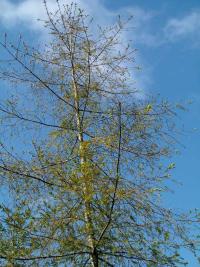
What is Swiss Needle Cast?
Swiss needle cast (SNC) is a foliage disease that is specific to Douglas-fir and is caused by the fungal pathogen Nothophaeocryptopus gaeumannii. SNC disease symptomsinclude chlorotic (yellow) needles and decreased needle retention, resulting in sparse crowns and reduced diameter and height growth. It is known as a cast disease, because it causes the tree to prematurely shed, or cast, its needles. Although it is called Swiss needle cast, the fungus that causes this disease is native to the western United States, and is an exotic pathogen in Europe, New Zealand and other places outside of Douglas-fir’s native range. However, the disease was first discovered in Douglas-fir plantations in Switzerland in the mid-1920s, and the name has persisted.
The fungus that causes SNC is native throughout the historical range of its host, Douglas-fir, and until the mid-1980s was considered an unimportant and minor pathogen. Under most conditions, the fungus that causes SNC is a benign component of the tree canopy and does not contribute to premature needle shed or growth loss. Nevertheless, SNC is has been causing an epidemic affecting hundreds of thousands of acres west of the Oregon coast range from Coos Bay to Astoria since the late 1980s and early 1990s. Annual aerial surveys conducted by the Oregon Department of Forestry (ODF) estimate that more than 300,000 acres have been impacted by the fungus each year since 2006, a consistent increase since aerial surveys began in 1996. Growth losses in the area of epidemic generally range from 20-50%, and annual growth impacts are estimated to exceed $200 million per year (Maguire et al. 2002).
Disease is most damaging close to the coast, and severe disease has been associated with several climate and topographic variables, including spring leaf wetness from precipitation and fog, mild temperatures in the winter and spring, and low-elevation valleys. It is believed that the current epidemic is attributable to a variety of factors, particularly the increase in Douglas-fir plantation acreage in coastal areas that were previously dominated by spruce, hemlock and alder and have environmental and site conditions conducive to disease development. Much of the current research is focused on understanding the impacts of soil and foliage nutrition on Swiss needle cast disease development and severity, assessing disease growth impacts, and modeling and mapping the current and projected distribution of disease.
SNC Disease Cycle: Infection of needles takes place in late-spring and early-summer, when ascospores are discharged from mature fruiting bodies (pseudothecia) on infected needles. Spore release coincides with the emergence and elongation of new foliage from buds, and newly formed needles are highly susceptible to infection (little or no infection of older needles occurs). Ascospores are wind and water-splash dispersed, and cause infection when they land on susceptible foliage, germinate, and enter needles through needle stomates. The threadlike body of the fungus (hyphae) continues to grow in the intercellular (between cells) space within the needle over many months, and fruiting bodies begin to develop in stomatal cavities (the epistomatal chamber). Under “ideal” disease conditions, immature pseudothecia may be visible on needles within 6 months of infection. Infection by one spore may result in the development of many pseudothecia on a single needle, because the fungus is able to expand within individual needles in the months and years following infection. The lifecycle is completed when pseudothecia mature, and release ascospores in the spring. Because infection can increase on infected needles over several years, relatively more fungal biomass and fruiting bodies are present within/on older needles compared to younger needles. As a higher proportion of stomates on a needle become blocked by the fungal fruiting bodies, there is an increased likelihood that the needle will be shed.
Mechanism of infection: The fruiting bodies (pseudothecia) cause a physical blockage (occlusion) of needle stomates, and this inhibits the uptake of carbon dioxide from the atmosphere for photosynthesis. When a threshold proportion of stomates are blocked (30-50%), the carbon cost of respiration exceeds the carbon gained through photosynthesis, and the needle becomes “carbon starved”. In these cases, it is beneficial for the tree to cast the needle. Researchers have also postulated that the reduction of carbon intake may also lead to the accumulation of damaging photo-oxidative chemicals within the needle (greater amounts of excess absorbed light absorbed by the needle relative to its photosynthetic capacity). This helps to explain why more severe defoliation is observed in the upper crowns of diseased trees. Trees that have fewer than 3 to 3.5 years of needles are likely to experience moderate to significant growth loss compared to trees with longer needle retention.